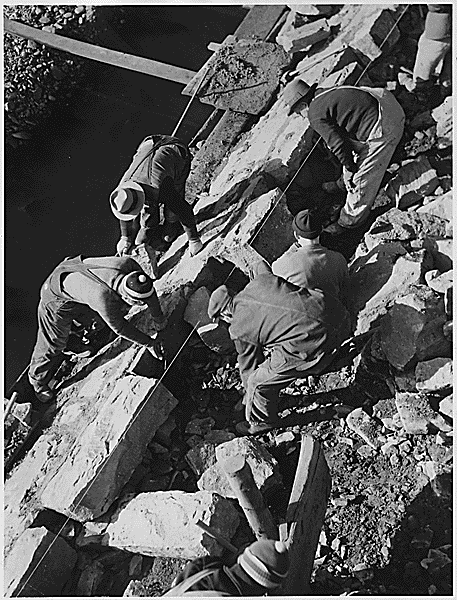*Image Credit: Wikimedia Commons In the midst of the Great Depression, President of the United States Franklin Delano Roosevelt launched an ambitious program to put Americans to work on behalf of the nation. As part of the Emergency Relief Appropriation Act (ERAA), the Works Progress Administration (WPA) was formed on April 8, 1935. Over the next eight years, the program provided nearly eight million jobs and left a mark on the US seen all over the country today. When the stock market crashed late in 1929, the world economy collapsed within days. In the US, the effects were dramatic: in four years, one in every four employable adults was without a job. Even with a slight improvement the following year, 21.7 per cent of Americans were still looking for work at the end of 1934. Roosevelt’s predecessor, Herbert Hoover, had already created a loan program to help states provide help — the Federal Emergency Relief Administration (FERA) — but the Democrat from New York sought to do more. His first move, just months after taking office following the 1932 presidential election, was to shift FERA in a new direction: instead of charging interest on all monies lent to the states, Roosevelt asked Congress to give out some of the funds in grants. The first part of a larger “New Deal,” the restructured program created openings for unskilled workers and, despite being more expensive than simple payments directly to the unemployed, proved to be a crucial psychological boost to a hurting workforce. Still, many Americans remained unable to find a job. Concerned the colder winter months would end up leaving those still out of work freezing to death, FERA created a five-month Civil Works Administration (CWA) to take on projects for public benefit and offer a further 4 million people temporary employment. The billion-dollar program resulted in millions of feet of sewer construction, not to mention hundreds of thousands of miles of roads and tens of thousands of schools. Pleased with the results but keenly aware of the criticisms of the CWA — some jobs took on basic yardwork, for example — Roosevelt made the decision to pursue another course, one with a more permanent effect on the nation as a whole. Turning to Harry Hopkins, the former head of FERA, Roosevelt sought ways to continue investing in infrastructure while also creating opportunities for other trades — artists, writers, researchers and so forth. By focusing on providing real work instead of simply a monthly stipend, the two were certain the country would recover faster from the economic devastation still evident after the Stock Exchange free fall of 1929. On April 8, 1935, the ERAA became law, giving Hopkins permission to allocate FERA funding to create the WPA. Working in conjunction with state and local governments, the program created openings for 30-hour-per-week jobs at regionally-appropriate wages — a man working in New York City would earn a larger paycheck than a man doing similar projects in South Dakota to fit the higher cost of living. Beyond offering up employment, the WPA ensured children were fed, clothed and given shelter. Totalling almost $5 billion in its first year, it was clear to Hopkins the program was a rousing success. “Give a man a dole and you save his body and destroy his spirit,” he said. “Give him a job and you save both body and spirit.” While roads, parks and bridges were being constructed in nearly every community across the country, artists and playwrights went to work creating cultural expressions matching the times. Hundreds of massive murals were painted and thousands of pieces of sculpture were installed in public places, all while researchers dove into historical studies and conducted archaeological digs. At an average cost of $41.57 per month for each worker, the WPA was only marginally more expensive than the $40 given to those out of work, but had the added benefit of allowing people the dignity of work while accomplishing something that would benefit the country long term. Officially cancelled in 1943, the WPA had nearly faded into memory by that point. With the Americans deeply involved in World War II, jobs were much easier to come by and could instead be applied to equipping soldiers and sailors to fight in Europe or the Pacific. Even to this day, the results of the $13.4 billion program can still be seen: the Griffith Observatory in Los Angeles and Merritt Parkway in Connecticut are just two of the hundreds of construction projects still standing nearly eight decades later. Though not without its critics — early problems with fair representation of African-Americans and the disproportionate amounts spent in the North and West were major issues — the WPA is usually seen as “the largest and most successful relief operation in American history,” according to expert Nathan Miller. Also On This Day: 1767 – The Kingdom of Ayutthaya, modern Thailand, is conquered by Burmese invaders 1820 – The Greek sculpture Venus de Milo is found on the island of Melos in the Aegean Sea 1895 – The United States Supreme Court rules an income tax on interest gained or rents charged unconstitutional in Pollock v. Farmers’ Loan & Trust Co. 1904 – Longacre Square in New York City is renamed, taking on its current designation of Times Square 1942 – The Imperial Japanese Army captures the Philippine province of Bataan
April 8 1935 – The Works Progress Administration is Formed
*Image Credit: Wikimedia Commons In the midst of the Great Depression, President of the United States Franklin Delano Roosevelt launched an ambitious program to put Americans to work on behalf…
